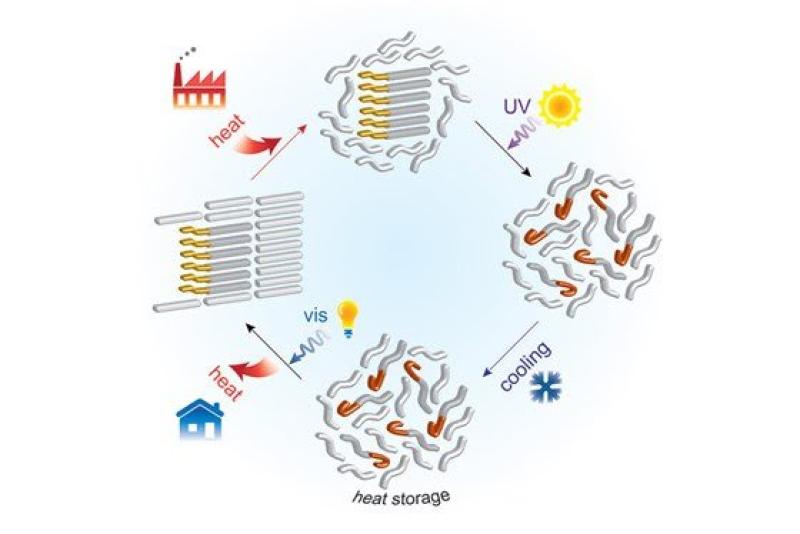Revolutionary new 'battery' could let us bottle sunshine



A plastic-like material may do for solar power what high-performance electrical batteries have done for iPhones and Tesla cars.
Solar energy is clean, abundant, and irritatingly inconvenient: It doesn’t work at night or on cloudy days. You can convert sunshine into electricity and store it in a battery, but that’s complicated and expensive. And much of the time, what you really want isn’t electricity but heat for tasks like cooking or warming homes.
What you want, in other words, is a way to bottle the heat of the noonday sun and then uncork it on demand. That sounds almost impossible, but some very determined scientists have found a way to make it happen — and they're convinced the technology could be transformative.
A team led by Dr. Dhandapani Venkataraman, a chemist at the University of Massachusetts, reported last month on a new polymer that is stunningly effective at absorbing and releasing heat. Dubbed AzoPMA , the plastic-like material could be the key to the development of a high-efficiency “thermal battery” that could do for solar tech what high-performance electrical batteries have done for iPhones and Tesla cars.
The underlying principle of a thermal battery is simple. Any material that holds heat qualifies. A swimming pool that warms up on a sunny August afternoon is a primitive thermal battery, for instance.
THERMAL SPONGES
What distinguishes AzoPMA is how much heat it can store. Ounce for ounce, it holds a record-setting 200 times as much thermal energy as water. The secret? Its molecules toggle between two shapes, or conformations.
When AzoPMA is exposed to sunlight, its molecules adopt their high-energy form. Then, when slightly warmed or activated by another trigger, the molecules revert to their low-energy form and the stored heat comes gushing out.
Meanwhile, Dr. Jeffrey Grossman, a materials scientist at MIT, is making impressive progress with another type of thermal storage. Grossman has created a fatty compound that melts when heated but , counterintuitively, doesn’t freeze when it cools. It stays melted until activated with a blue LED. Only then does it solidify, releasing its locked-up heat.
“We’re creating materials that store thermal energy in completely new ways,” Grossman says.
WHAT TO DO WITH BOTTLED SUNSHINE
Solar thermal batteries may find their first applications in the developing world.
Tata, the Indian industrial conglomerate, is funding the development of solar-thermal ovens that could replace the ubiquitous rural stoves that burn wood, brush, or dung. Fumes from those stoves are a major health hazard. A couple of liters of battery material would hold enough heat for an hour’s worth of emission-free cooking each day.
“Or imagine when go camping, you’d be charging the molecules while you are hiking, then you’d discharge them to cook your dinner,” Venkataraman says. Along the same lines, a colleague at MIT is incorporating thermal-storage batteries into textile fibers, so your hiking jacket and socks might collect warmth during the day and then release it on command at night, after you’ve finished your solar-heated meal.
Thermal batteries could also be bundled up into big storage units to heat entire homes, or spread out as thin films on roadways, rooftops, and car windshields, where they could rapidly melt away snow after winter storms — without any electricity. BMW has been exploring that last idea with Grossman’s team.
Once heat-storage tech becomes practical — perhaps in as little as a decade — Grossman expects many other new uses to open up. “Thermal batteries today are where electrical batteries were a century ago,” he says. “There are exciting applications we’re only starting to understand.”


Twenty years ago, we had no idea where cell phone technology would take us in twenty years time. I have high hopes for this newly emerging technology as well. Imagine roads that don’t need salting, houses that absorb heat during the day to heat themselves at night, an outdoor grill that doesn’t need propane ... the potential uses are endless. We’ll no doubt be fighting the fossil fuel industry every step of the way.
When you tell people they can just reach outside and bottle their own sunshine and power their lives cleanly and cheaply there are only two kinds of people who are appalled at the idea, those selling fossil fuel energy and those hired to harvest fossil fuel for them.
I think we will likely always need some amount of fossil fuels, since they have such high potential for the energy release needed to melt the steel needed for machinery that can manufacturer green materials. Fossil fuels just need to be marginalized as much as possible.
i see a Trumpp ban comin
I love to hear about stuff like this. It may or may not come to anything... but it's cool!
4 earth too
.
oil companies to by Patten, in General
Good news. Whether it works or not in the final analysis remains to be seen, but it's a great start.
I think this will turn out to be a good thing